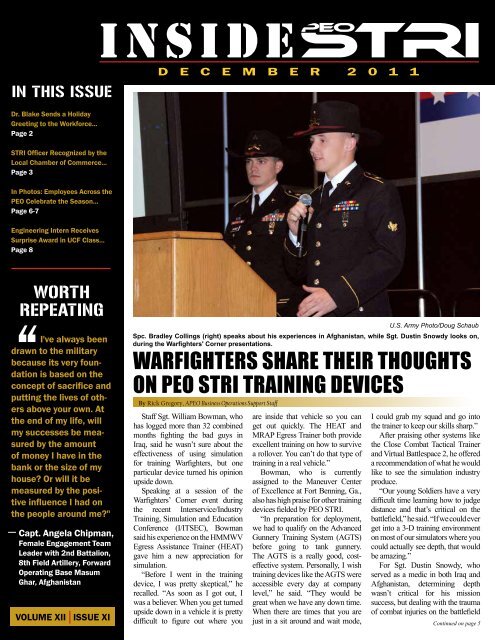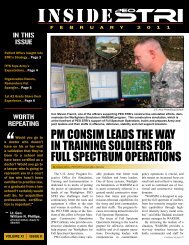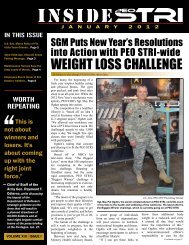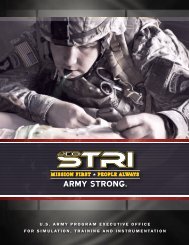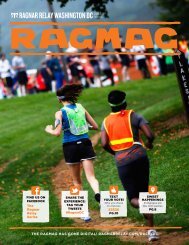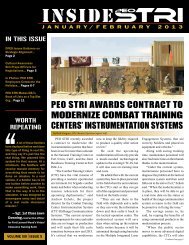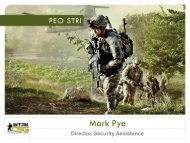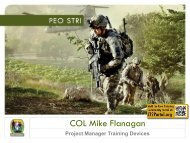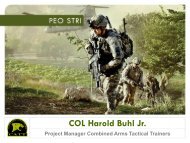InsIde - PEO STRI - U.S. Army
InsIde - PEO STRI - U.S. Army
InsIde - PEO STRI - U.S. Army
Create successful ePaper yourself
Turn your PDF publications into a flip-book with our unique Google optimized e-Paper software.
Inside<br />
In this Issue<br />
D E C E M B E R 2 0 1 1<br />
Dr. Blake Sends a Holiday<br />
Greeting to the Workforce...<br />
Page 2<br />
<strong>STRI</strong> Officer Recognized by the<br />
Local Chamber of Commerce...<br />
Page 3<br />
In Photos: Employees Across the<br />
<strong>PEO</strong> Celebrate the Season...<br />
Page 6-7<br />
Engineering Intern Receives<br />
Surprise Award in UCF Class...<br />
Page 8<br />
Worth<br />
Repeating<br />
I've always been<br />
drawn to the military<br />
because its very foundation<br />
is based on the<br />
concept of sacrifice and<br />
putting the lives of others<br />
above your own. At<br />
the end of my life, will<br />
my successes be measured<br />
by the amount<br />
of money I have in the<br />
bank or the size of my<br />
house? Or will it be<br />
measured by the positive<br />
influence I had on<br />
the people around me?"<br />
Capt. Angela Chipman,<br />
Female Engagement Team<br />
Leader with 2nd Battalion,<br />
8th Field Artillery, Forward<br />
Operating Base Masum<br />
Ghar, Afghanistan<br />
VOLUME XII ISSUE XI<br />
Spc. Bradley Collings (right) speaks about his experiences in Afghanistan, while Sgt. Dustin Snowdy looks on,<br />
during the Warfighters' Corner presentations.<br />
Warfighters Share Their Thoughts<br />
on <strong>PEO</strong> <strong>STRI</strong> Training Devices<br />
By Rick Gregory, A<strong>PEO</strong> Business Operations Support Staff<br />
Staff Sgt. William Bowman, who<br />
has logged more than 32 combined<br />
months fighting the bad guys in<br />
Iraq, said he wasn’t sure about the<br />
effectiveness of using simulation<br />
for training Warfighters, but one<br />
particular device turned his opinion<br />
upside down.<br />
Speaking at a session of the<br />
Warfighters’ Corner event during<br />
the recent Interservice/Industry<br />
Training, Simulation and Education<br />
Conference (I/ITSEC), Bowman<br />
said his experience on the HMMWV<br />
Egress Assistance Trainer (HEAT)<br />
gave him a new appreciation for<br />
simulation.<br />
“Before I went in the training<br />
device, I was pretty skeptical,” he<br />
recalled. “As soon as I got out, I<br />
was a believer. When you get turned<br />
upside down in a vehicle it is pretty<br />
difficult to figure out where you<br />
are inside that vehicle so you can<br />
get out quickly. The HEAT and<br />
MRAP Egress Trainer both provide<br />
excellent training on how to survive<br />
a rollover. You can’t do that type of<br />
training in a real vehicle.”<br />
Bowman, who is currently<br />
assigned to the Maneuver Center<br />
of Excellence at Fort Benning, Ga.,<br />
also has high praise for other training<br />
devices fielded by <strong>PEO</strong> <strong>STRI</strong>.<br />
“In preparation for deployment,<br />
we had to qualify on the Advanced<br />
Gunnery Training System (AGTS)<br />
before going to tank gunnery.<br />
The AGTS is a really good, costeffective<br />
system. Personally, I wish<br />
training devices like the AGTS were<br />
accessible every day at company<br />
level,” he said. “They would be<br />
great when we have any down time.<br />
When there are times that you are<br />
just in a sit around and wait mode,<br />
U.S. <strong>Army</strong> Photo/Doug Schaub<br />
I could grab my squad and go into<br />
the trainer to keep our skills sharp.”<br />
After praising other systems like<br />
the Close Combat Tactical Trainer<br />
and Virtual Battlespace 2, he offered<br />
a recommendation of what he would<br />
like to see the simulation industry<br />
produce.<br />
“Our young Soldiers have a very<br />
difficult time learning how to judge<br />
distance and that’s critical on the<br />
battlefield,” he said. “If we could ever<br />
get into a 3-D training environment<br />
on most of our simulators where you<br />
could actually see depth, that would<br />
be amazing.”<br />
For Sgt. Dustin Snowdy, who<br />
served as a medic in both Iraq and<br />
Afghanistan, determining depth<br />
wasn’t critical for his mission<br />
success, but dealing with the trauma<br />
of combat injuries on the battlefield<br />
Continued on page 5
A Message from the <strong>PEO</strong><br />
To my <strong>PEO</strong> <strong>STRI</strong> family,<br />
On Christmas Eve of 1776, General George Washington, the commander-in-chief of<br />
the Continental <strong>Army</strong>, met with his war council in Buckingham, Pa., to solidify what<br />
he hoped would be the turning point in America's War for Independence—crossing<br />
the Delaware River in the dead of winter, culminating in a surprise attack on the<br />
British forces. The future of this newly-declared Nation rested solely on the mission’s<br />
successful outcome.<br />
Overcoming the challenges seemed nearly insurmountable. Many of Gen.<br />
Washington's troops were sick, hungry, poorly clothed and suffering through one of<br />
the coldest winters on record. Greatly outnumbered and reaching the limits of human<br />
endurance, the American <strong>Army</strong> was no match for the professional British <strong>Army</strong>,<br />
warmly dwelling across the river in Trenton, N.J. Gen. Washington knew, however, that<br />
their complacency and lowered guards gave rise to opportunity.<br />
Within 24 hours, at midnight on Dec. 25, 1776, Washington executed the crossing of<br />
the Delaware, and the rest is history; Washington’s “brilliant stroke” tipped the scales<br />
in the Revolutionary War.<br />
And ever since that Christmas of 1776, American men and women in uniform<br />
have spent many Christmases on battlefields across the globe… in Europe, Africa,<br />
throughout the Pacific, on the Korean Peninsula and in Vietnam, and from Kuwait to<br />
Iraq and Afghanistan.<br />
This season, we gather with our families and friends in a Nation free to celebrate in<br />
the custom of our choosing, by whatever name or tradition it is known, thanks to the<br />
long and unbroken line of patriots whose courage and sacrifice continue to secure the<br />
blessings of freedom and liberty upon our grateful Nation.<br />
Throughout the year, and especially during the holiday season, I ask that you<br />
keep our deployed Soldiers in your thoughts and prayers. They are proof that the<br />
dedication, professionalism and operational excellence of our <strong>Army</strong> are unparalleled.<br />
Sharon and I extend our most heartfelt holiday greetings to each one of you and your<br />
families. This season is a special time in the Blake household, a chance to spend extra<br />
time with family and friends, reflect on the past year and anticipate the opportunities<br />
that lie ahead.<br />
On behalf of Sharon and I, and the entire leadership team, you have our sincerest<br />
appreciation for your dedicated service and our warmest wishes for a joyous holiday<br />
season and a prosperous 2012.<br />
Dr. James T. Blake<br />
Program Executive Officer<br />
2
PM CATT Soldier Honored by Local<br />
Hispanic Chamber of Commerce<br />
By Rick Gregory, A<strong>PEO</strong> Business Operations Support Staff<br />
Lt. Col. Wilson Ariza, assistant<br />
project manager for medical<br />
simulation in PM CATT, was<br />
recently honored by the Hispanic<br />
Chamber of Commerce of<br />
Metro Orlando and the Hispanic<br />
Business Initiative Fund as a<br />
finalist in the annual Don Quixote<br />
Awards.<br />
The Don Quixote Awards,<br />
according to the website,<br />
“were created to recognize and<br />
celebrate the entrepreneurial<br />
spirit of individuals who have<br />
shown character of great<br />
strength, courage, conviction and<br />
determination, just as the beloved<br />
character of Spanish literature.”<br />
More than 100 nominations<br />
were received for the six award<br />
categories. After a seven-step<br />
selection process, Ariza was<br />
one of three finalists in the<br />
Excellence Award category that<br />
recognizes Hispanic individuals<br />
whose contributions have<br />
elevated the face of the Hispanic<br />
community. To be nominated,<br />
award finalists need to have<br />
shown evidence of significant<br />
innovations and contributions to<br />
the Central Florida community,<br />
demonstrated leadership and<br />
community involvement and<br />
received significant honors or<br />
awards.<br />
Ariza, along with his wife,<br />
Nitza, are certainly no strangers<br />
to not only the local Hispanic<br />
community, but also those<br />
communities where his <strong>Army</strong><br />
assignments have taken them.<br />
In 1995, the couple<br />
implemented a youth group in<br />
conjunction with the city of San<br />
Antonio and Fort Sam Houston.<br />
Called “La Salida” (The Way<br />
Out), the program focused on<br />
children living in economically<br />
depressed areas and exposed<br />
to gangs and gang-recruitment<br />
efforts. Activities included<br />
achieving physical challenges,<br />
like repelling and navigating<br />
rope bridges, and learning about<br />
living a drug-free, gang-free and<br />
education-oriented life.<br />
“For many of the children, the<br />
program offered these children<br />
the opportunity to eat three meals<br />
a day for the first time in their<br />
lives,” Ariza said.<br />
Believing that leadership and<br />
mentoring within youth groups is<br />
an investment in a better world,<br />
Ariza has initiated seven youth<br />
groups where none previously<br />
existed. The first group, which he<br />
started while attending church in<br />
Gaithersburg, Md., has grown to<br />
more than 100 members. He has<br />
also worked at churches to help<br />
immigrants of all nationalities<br />
complete the paperwork required<br />
by the U.S. Citizenship and<br />
Immigration Services or to start<br />
a new business.<br />
While providing community<br />
service at his local church, he,<br />
along with four other individuals<br />
statewide, was appointed as a<br />
liaison for the local Hispanic<br />
community. The community<br />
outreach committee has the<br />
responsibility of helping address<br />
the needs of a growing Hispanic<br />
community in the Central Florida<br />
area.<br />
Ariza and his wife are also<br />
involved in an 18-month<br />
project for the International<br />
Baccalaureate Program at<br />
Seminole High School in<br />
Sanford. Created by Mrs. Ariza,<br />
the “Dare To Care” program<br />
supports Florida service members<br />
and their families during their<br />
deployment.<br />
Besides being acknowledged<br />
Photo courtesy of the Hispanic Chamber of Commerce of Metro Orlando<br />
Lt. Col. Wilson Ariza holds the finalist award he received at the Don Quixote Award ceremony. The award was<br />
presented by Ramon Ojeda (left), president of the Hispanic Chamber of Commerce of Metro Orlando, and Augusto<br />
Sanabria, president and CEO of the Hispanic Business Initiative Fund.<br />
for making a positive impact in<br />
the civilian communities, Ariza<br />
has also garnered many awards<br />
and decorations throughout his<br />
22 year military career.<br />
Among the many awards, he<br />
joined such luminaries as Neil<br />
Armstrong, Elizabeth Dole and<br />
Daniel Patrick Moynihan when<br />
he was selected to receive the<br />
Arthur S. Fleming Award which is<br />
bestowed on outstanding federal<br />
employees who are recognized<br />
by the President of the United<br />
States.<br />
His military awards include<br />
the Defense Meritorious Service<br />
Medal, <strong>Army</strong> Meritorious<br />
Service Medal, two each of<br />
the Joint Service Achievement<br />
Medal, <strong>Army</strong> Commendation<br />
Medal, <strong>Army</strong> Achievement<br />
Medal and NATO Medal<br />
and others.<br />
Inside <strong>STRI</strong> December 2011 3
Noe Santos, a wounded Warrior, and Jose Garcia-Aponte of <strong>PEO</strong> <strong>STRI</strong> PM CATT begin the 5K portion of the charitable event.<br />
U.S. <strong>Army</strong> Photo/Shelley Kaufeld<br />
Warrior Run Makes Great Strides<br />
By Rick Gregory, A<strong>PEO</strong> Business Operations Support Staff<br />
While most members of the<br />
<strong>PEO</strong> <strong>STRI</strong> workforce were nestled<br />
snug in their beds while visions of<br />
sugarplums danced in their heads in<br />
the early morning hours of Dec. 3,<br />
a spirited group of 121 employees<br />
and their family members were<br />
hitting the downtown pavement<br />
to participate in the Orlando<br />
Utilities Commission (OUC)<br />
half-marathon/5K charitable run.<br />
Though the annual run benefits the<br />
Florida Citrus Sports Foundation,<br />
a portion of the proceeds,<br />
approximately $5,000, donated<br />
by the <strong>PEO</strong> <strong>STRI</strong> runners went to<br />
help make holiday dreams come<br />
true for children who have lost their<br />
parents in the Iraq and Afghanistan<br />
conflicts. A special thank you goes<br />
out to all <strong>PEO</strong> <strong>STRI</strong> members who<br />
ran, walked, volunteered or donated<br />
to this special cause. The runners<br />
and walkers were Katherine<br />
Amaya, Elizabet Atiles-Ayala,<br />
Joseph Bladow, Maj. Mark Bliss,<br />
KeYanna Boone, Cindy Brandl,<br />
Mark Brzezinski, Lt. Col. William<br />
Canaley, Thomas Coffman, Anna<br />
Crossway, Rayvan Davis Sr., Maj.<br />
Robert DeGaine, Valerie Deneen,<br />
Sgt. 1st ClassTracy Drowne, Neal<br />
Eskin, William Eubanks, Lt. Col.<br />
Mark Evans, Fran Fierko, Col.<br />
Mike Flanagan, Maj. Cassandra<br />
Forrester, Jose Garcia-Aponte,<br />
John Geisinger, Joe Giunta,<br />
Bridgette Graham, Lawence<br />
Green, Lt. Col. Richard Haggerty,<br />
Eric Hertl, Steven Horvath, Gary<br />
Jeffers, William Jensen, Donald<br />
Johnson, Traci Jones, Randi Kahl,<br />
Marcia Kain, Ray Karnaz, Maj.<br />
Thomas Kelley, Allison Laera, Lisa<br />
Lehneke, Kaitlin Lockett, Mike<br />
Marone, Russ McBride, Holley<br />
McNeely, Rhonda Meyers, David<br />
Meyers, Thomas Monaghan, Maj.<br />
Sabrina Moore, Sgt. Maj. Pat<br />
Ogden, Rachel Overman, Lovisa<br />
Parks, Frances Purser, Lt. Col.<br />
Craig Ravenell, Frank Rhinesmith,<br />
Robert Rowland, Shaun Schneider,<br />
Michael Sims, Jerry Sirmans, Lt.<br />
Col. Keith Smith, Molly Stoute,<br />
Kim Tedeschi, Ken Tedeschi,<br />
Lt. Col. Scott Tufts, Maj. Ralph<br />
Ware, Louise Williams, Cpt. Brian<br />
Williams, Lt. Col. Charles Worshim<br />
and Col. Mike Zarbo.<br />
4<br />
Inside <strong>STRI</strong> December 2011
WARFIGHTERS' CORNER:<br />
continued from page 1<br />
was.<br />
“One of the biggest things we saw<br />
downrange was the psychological<br />
impact on new medics when<br />
they got their first casualties,” he<br />
explained. “We had everything from<br />
Soldiers freezing up to others getting<br />
sick and not being able to cope with<br />
the trauma. They needed to have<br />
gone through a simulated battlefield<br />
situation where they experienced<br />
the realistic feel, smell and sights of<br />
actual trauma.”<br />
Snowdy feels the Medical<br />
Simulation Training Centers<br />
(MSTC) go a long way in preparing<br />
medics for just that.<br />
“The realistic training that we do<br />
in the MSTC helps get these Soldiers<br />
in the frame of mind that they will<br />
need to treat those casualties on the<br />
real battlefield,” he said. “I can’t<br />
express how important that is as<br />
a medic. To be able to actually see<br />
the injury and live that experience<br />
in training is what I believe is<br />
vital to the success of performing<br />
downrange.<br />
“There is a certain mindset that<br />
you have to have when treating a<br />
patient,” Snowdy continued. “Every<br />
medic has to be in a mindset that<br />
says ‘Hey, I’m not God. I can’t save<br />
every patient I come across.’ MSTC,<br />
in my mind, helps us mentally<br />
prepare for the worst case scenario<br />
where we are going to see a patient<br />
who could be one of our buddies<br />
who we can’t save.”<br />
Spc. Bradley Collings, a medic<br />
who served a tour in Afghanistan,<br />
experienced the worst case scenario<br />
shortly after arriving in country.<br />
“The first thing I saw traumawise<br />
was when an Afghan soldier<br />
stepped on an improvised explosive<br />
device,” Collings recalled. “It<br />
basically pulverized him. He flew<br />
up in the air with body pieces going<br />
everywhere.”<br />
Though he had only three months<br />
of train-up time before deploying<br />
with his unit, he did get to gain<br />
experience in the MSTC twice and<br />
he credits that with preparing him<br />
for the harsh medical realities of war.<br />
“At the MSTC you get the sights,<br />
the smells and the adrenalin rush,”<br />
he explained. “The experience of<br />
going in the MSTC and treating<br />
a simulated casualty who was<br />
breathing, bleeding and moving<br />
coupled with the simulated chaos<br />
of the sounds of battle helped a lot.<br />
When you have that experience in<br />
the MSTC, you start to build that<br />
confidence inside yourself that you<br />
know you can help your buddy live<br />
and go home to his family. That, in<br />
itself, helped me not freeze up in<br />
the instant when the casualty was a<br />
real person in front of me and not a<br />
Staff Sgt. William Bowman briefs the Warfighters' Corner attendees on the<br />
pre-deployment training he received prior to deploying to Iraq.<br />
rubber person.”<br />
While Collings lauds the MSTC,<br />
there are two improvements he<br />
would like to see implemented<br />
for future medics training for<br />
deployment.<br />
“I would like to train on a nontethered<br />
mannequin that bleeds and<br />
breathes like the tethered ones,” he<br />
said. “In training you could treat<br />
him on the spot where he got hit<br />
and continue treating him until you<br />
either bring him back to the aid<br />
station or put him on a helicopter<br />
for evacuation. That would be great<br />
training!”<br />
A simulation device that would<br />
help combat medics identify<br />
traumatic brain injuries would also<br />
Photo courtesy of U.S. <strong>Army</strong> Photo/Doug Schaub<br />
be helpful, Collings said.<br />
“Brain injury is one of the main<br />
injuries we are seeing in the war,”<br />
he explained. “I would like the see<br />
the development of a traumatic<br />
brain injury simulator that shows<br />
you the difference in the dilation<br />
of the pupils and the other types of<br />
symptoms of brain injury that you<br />
will see on the battlefield as a medic.<br />
We need something that will show<br />
us the early warning signs.”<br />
The theme for I/ITSEC this year<br />
was “Prepare The Force, Secure<br />
The Future.”All of the Warfighters<br />
who spoke during I/ITSEC provided<br />
testament of how <strong>PEO</strong> <strong>STRI</strong> training<br />
devices are indeed preparing the<br />
force.<br />
New Law Will Expedite Soldiers<br />
Through Airport Security<br />
By <strong>Army</strong> News Service<br />
A bill signed into law by the<br />
president Jan. 3 means Soldiers in<br />
uniform and their families may soon<br />
have an easier time moving through<br />
security screening lines at the airport.<br />
The "Risk-Based Security<br />
Screening for Members of the Armed<br />
Forces Act" calls for development of<br />
a plan that will provide "expedited<br />
security screening services for a<br />
member of the armed forces and, to<br />
the extent possible, any accompanying<br />
family member."<br />
Included in that law are instructions<br />
to consider establishing standards for<br />
screening of military uniform items,<br />
including combat boots.<br />
Only service members on orders<br />
and in uniform will be granted access<br />
to any expedited security screening<br />
procedures that have been developed,<br />
officials said.<br />
The new law calls for changes to be<br />
implemented within six months.<br />
Transportation Security<br />
Administration officials say the<br />
agency is now "in consultation with<br />
DoD," and "is reviewing options for<br />
implementing procedures that will<br />
adhere to the new law."<br />
Already, the TSA had policies in<br />
place that help expedite the movement<br />
of uniformed service members<br />
though the security screening process.<br />
Soldiers with proper identification are<br />
not required to remove their boots<br />
or shoes unless the footwear sets off<br />
screening equipment.<br />
Families of service members can<br />
obtain gate passes to go with service<br />
members to their departure gates<br />
to see them off, or to be standing at<br />
arrival gates when they get off the<br />
plane.<br />
Additionally, the TSA has worked<br />
with DoD to make it easier for<br />
injured service members to negotiate<br />
the screening process. The Military<br />
Severely Injured Joint Services<br />
Operations Center Program ensures<br />
that any screening is "conducted by<br />
TSA screening experts with empathy<br />
and respect in order to make the<br />
overall experience for the service<br />
member as expeditious and pleasant<br />
as possible."<br />
Inside <strong>STRI</strong> December 2011 5
2011<br />
Holiday Celebrations<br />
Across the <strong>PEO</strong><br />
6
Student-Intern Honored with <strong>Army</strong><br />
Award during UCF Engineering Class<br />
Information for the article was provided by UCF News & Information<br />
<strong>PEO</strong> <strong>STRI</strong> engineering intern<br />
Steven Horvath's career is on the<br />
fast track, and he's got a medal<br />
to prove it.<br />
PM TRADE Col. Mike<br />
Flanagan, UCF President<br />
John C. Hitt, Provost Tony<br />
Waldrop and a classroom full<br />
of engineering students were<br />
present Wednesday, Nov. 16,<br />
at Horvath's surprise award<br />
presentation, where he was<br />
given the Achievement Medal<br />
for Civilian Service.<br />
Horvath is the first student<br />
intern to receive this award in<br />
<strong>PEO</strong> <strong>STRI</strong>.<br />
Horvath worked for <strong>PEO</strong><br />
<strong>STRI</strong> for 18 months, serving as<br />
an assistant engineer and aiding<br />
the office in a variety of respects.<br />
"For a while, I didn't even<br />
realize Steven was a student,"<br />
Flanagan said. "I thought he was<br />
a seasoned engineer."<br />
The in-class surprise award<br />
ceremony lasted for just a few<br />
minutes, but Horvath said it was<br />
extremely impactful.<br />
Professor Faissal Moslehy<br />
asked Horvath and his fellow<br />
engineering students to remain<br />
in the classroom mid-lecture, as<br />
very important guests were to<br />
arrive.<br />
"Once I saw Col. Flanagan<br />
come in, I thought that maybe<br />
this had something to do with<br />
me," Horvath said, referring to<br />
the moment when a hush rippled<br />
through the classroom as his<br />
<strong>PEO</strong> <strong>STRI</strong> superiors, Hitt and<br />
Waldrop entered the room. "I've<br />
never received anything like this<br />
before, so it's an honor to be so<br />
young and have this award."<br />
During the ceremony, Col.<br />
Flanagan listed off reasons<br />
for Horvath's professional<br />
excellence and presented him<br />
with a medal and certificate.<br />
Horvath said that he<br />
attributes his personal success<br />
to his willingness to help others<br />
at his job and through his close<br />
relationship with his mentor.<br />
"My experience in a trained,<br />
professional environment has<br />
been great for my future job,"<br />
Horvath said.<br />
Flanagan said that Horvath<br />
has worked on a variety of<br />
projects for <strong>PEO</strong> <strong>STRI</strong>, the<br />
most notable being a workshop<br />
that brought together members<br />
of industry and government to<br />
demonstrate the significance<br />
of "cloud computing" in the<br />
training of U.S. Soldiers.<br />
Other contributions Horvath<br />
has made to <strong>PEO</strong> <strong>STRI</strong><br />
during his time as an intern<br />
include performing onsite<br />
test engineering support<br />
for a wireless range data<br />
communication system and<br />
conducting a study on energy<br />
reduction techniques for a<br />
Moving Armor Target — a<br />
robotic moving target used for<br />
a variety of gunnery training<br />
applications.<br />
Horvath also co-authored a<br />
paper titled "Next Generation of<br />
Distributed Training Utilizing<br />
SOA, Cloud Computing,<br />
and Virtualization" which<br />
he presented at the 2011<br />
Interservice/Industry Training,<br />
Simulation and Education<br />
Conference.<br />
Jeremy Lanman, who has<br />
Photo courtesy of U.S. <strong>Army</strong> Photo/Doug Schaub<br />
Col. Mike Flanagan presents Steven Horvath with the Achievement Medal for Civilian Service while UCF President<br />
John C. Hitt looks on Nov. 16 during Horvath's engineering class.<br />
served as Horvath's task-lead<br />
and mentor at <strong>PEO</strong> <strong>STRI</strong>, said<br />
that the award presented to the<br />
intern is a great honor and will<br />
remain on his permanent record<br />
as long as he remains a federal<br />
employee.<br />
After graduating with his<br />
bachelor's in mechanical<br />
engineering this December,<br />
Horvath will be working as a<br />
nuclear systems crew trainer for<br />
the U.S. Navy in Charleston,<br />
S.C. He will primarily be<br />
responsible for instructing Navy<br />
personnel on how to operate<br />
nuclear submarines.<br />
"I know he'll do really well up<br />
there," Lanman said. "He's got a<br />
can-do attitude, and all around<br />
he's been the perfect employee."<br />
8<br />
Inside <strong>STRI</strong> December 2011
PM TRADE Team Honored at I/ITSEC for<br />
Live Training Software Product Line<br />
By Rick Gregory, A<strong>PEO</strong> Business Operations Support Staff<br />
While members of Congress<br />
have been wringing their hands<br />
trying to find ways to save the<br />
U.S. government money, a team<br />
from <strong>PEO</strong> <strong>STRI</strong>’s PM TRADE<br />
has earned an award for a<br />
product line that will realize an<br />
estimated $350 million in cost<br />
avoidance across the military<br />
services.<br />
The PM TRADE team took<br />
top honors for Outstanding<br />
Achievement in Modeling and<br />
Simulation in the Acquisition<br />
Category of the 2011 National<br />
Training and Simulation<br />
Association award ceremony<br />
during the Interservice/Industry<br />
Training, Simulation and<br />
Education Conference held<br />
recently in Orlando.<br />
Called Live Training<br />
Transformation (LT2), the<br />
product line provides state-ofthe-art<br />
training systems to the<br />
Warfighter by using common<br />
reusable software components,<br />
architectural infrastructure,<br />
interfaces, standards, processes<br />
and assets. By making the<br />
product line a “one size fits all”<br />
in commonality and reusability,<br />
it has proven to significantly<br />
reduce costs for the <strong>Army</strong> and<br />
other military services.<br />
“The continuing transformation<br />
has generated a significant<br />
return-on-investment within<br />
PM TRADE’s live training<br />
system acquisition portfolio by<br />
generating an estimated $350<br />
million in cost avoidance for the<br />
<strong>Army</strong> across development and<br />
sustainment,” said Tom Coffman,<br />
assistant project manager with<br />
PM TRADE.<br />
The Marine Corps also<br />
realized significant savings<br />
using the LT2 product line when<br />
developing its Instrumented<br />
Training System (ITS), Coffman<br />
noted. Using 87 percent of LT2’s<br />
product line software, the Corps<br />
not only saved $11 million in<br />
development and acquisition<br />
costs, but also completed the<br />
project seven years sooner than<br />
originally planned.<br />
Additionally, when the Air<br />
Force looked at developing a<br />
Counter Improvised Explosive<br />
Device After Action Review<br />
System, they turned to the<br />
<strong>Army</strong>’s LT2 product line.<br />
With very little development<br />
investment, the Air Force was<br />
able to quickly field seven<br />
training systems to meet their<br />
IED training needs to support<br />
deploying Air Force personnel<br />
at four bases.<br />
The LT2 product line<br />
architecture, standards, assets<br />
and environment have been used<br />
by more than 16 major <strong>Army</strong><br />
and Department of Defense live<br />
training programs with more<br />
than 130 systems fielded. It is<br />
Photo courtesy of NTSA<br />
Fred Lewis, president of NTSA (right), presents the Outstanding Achievement in Modeling and Simulation in the<br />
Acquisition Category award to Tom Coffman and Col. Mike Flanagan of PM TRADE.<br />
recognized as the <strong>Army</strong>’s live<br />
training standard.<br />
The LT2 team is comprised of<br />
Marie Bittikofer, Tom Coffman,<br />
Mark Dasher, Michael Dillon,<br />
Graham Fleener, Michelle<br />
Fox, Michelle Garcia Gomez,<br />
Danielle Genaro, Steven Horvath,<br />
Thomas Kehr, Brian Kemper,<br />
Dr. Jeremy Lanman, Andrea<br />
Morhack, Tuan Nguyen, Angela<br />
Pritchard, Eric Ravelo, Patrick<br />
Sincebaugh, Jim Styerwalt, James<br />
Todd and Derek Vick.<br />
Inside <strong>STRI</strong> December 2011 9
BOO Takes First Place in Golf Tourney<br />
for Seventh Straight Year<br />
By Kristen McCullough, Publix Affairs Officer<br />
Photo courtesy of www.findthebest.com<br />
<strong>PEO</strong> <strong>STRI</strong> employees and their family members play at Eastwood Golf Club in Orlando, Fla., Dec. 26 for the <strong>PEO</strong> <strong>STRI</strong> Team Golf Championship.<br />
Droves of <strong>PEO</strong> <strong>STRI</strong> folks<br />
headed out to the links the<br />
day after Christmas to vie<br />
for the <strong>PEO</strong> <strong>STRI</strong> Team Golf<br />
Championship trophy, yet the<br />
match can hardly be considered<br />
a competition. The BOO team<br />
won yet again for the seventh<br />
consecutive year.<br />
BOO team members, Mr.<br />
Rob Reyenga, Ken Wheeler,<br />
Walt Pezzolo and Scott Gray,<br />
took first place, however their<br />
winning status provided them<br />
only a boost of pride. The same<br />
goes for the second place team<br />
from the CSG made up of Jim<br />
Godwin, Dusty Woodlee, Don<br />
Schlomer and Steve Goldberg.<br />
The third place team—and<br />
perhaps the most bountiful<br />
winner gaining 12 Org Day<br />
points—was PM ConSim<br />
finishing with the lowest PMshop<br />
score of 65.5 strokes.<br />
Teams from the Acquisition<br />
Center, PM Field OPS, PM<br />
ITTS and PM TRADE also<br />
participated in the 50-person<br />
golf outing at Eastwood Golf<br />
Club. PM CATT did not put<br />
together a team, and therefore<br />
did not earn Org Day points.<br />
Let’s hope they can make it up<br />
April 13 at Red Bug Lake Park.<br />
Org Day Points Earned<br />
PM POINTS NET SCORE<br />
PM Con Sim 12 65.5<br />
Acq. Center 10 66.5<br />
PM Field OPS 8 66.75<br />
PM ITTS 6 67.75<br />
PM TRADE 4 69.25<br />
PM CATT 0 DNS<br />
10<br />
Inside <strong>STRI</strong> December 2011
100%<br />
EXCEEDS CFC GOALS!<br />
90<br />
80<br />
70<br />
60<br />
50<br />
30<br />
10<br />
40<br />
20<br />
0<br />
GOAL: $75,000<br />
RAISED: $102,000<br />
+<br />
The generosity of the <strong>PEO</strong> <strong>STRI</strong> team helped the<br />
organization top its 2011 goal for the Combined<br />
Federal Campaign (CFC). CFC is the world's largest and<br />
most successful annual workplace charity campaign, with<br />
more than 200 CFC movements throughout the country and<br />
internationally to help to raise millions of dollars each year.<br />
Pledges made by federal civilian, postal and military donors<br />
during the campaign season (Sept. 1 to Dec. 15) support<br />
eligible non-profit organizations that provide health and<br />
human service benefits throughout the world.<br />
Inside <strong>STRI</strong> December 2011 11
Team Orlando in Photos<br />
Photo courtesy of Mike Sardello<br />
Col. Mike Zarbo, project manager for PM ITTS, gives the Veteran's<br />
Day keynote address to more than 1,000 attendees in his hometown<br />
of Wakefield, Mass. He commemorated the dedication of the World<br />
War II memorial recently built in the town.<br />
Photo courtesy of U.S. <strong>Army</strong> Photo/Doug Schaub<br />
UCF head football coach George O'Leary (right) and the coach's<br />
special assistant Manny Messeguer try their hands at <strong>PEO</strong> <strong>STRI</strong>'s<br />
Engagement Skills Trainer Dec. 8. After a little sharp shooting,<br />
O'Leary addressed members of the Team Orlando workforce in<br />
an insightful presentation on the parallel between playing and<br />
coaching football and serving in the military<br />
Photo courtesy of U.S. <strong>Army</strong> Photo/Doug Schaub<br />
The <strong>Army</strong> team made up of <strong>PEO</strong> <strong>STRI</strong> employees takes on the Navy<br />
team of NAWCTSD personnel in the annual Turkey Bowl Nov. 16.<br />
Photo courtesy of U.S. <strong>Army</strong> Photo/Doug Schaub<br />
The <strong>Army</strong>/Air Force team defeats the Navy/Marine Corps team in<br />
the Dec. 8 sand volleyball match.<br />
Photo courtesy of U.S. <strong>Army</strong> Photo/Doug Schaub<br />
John Collins (left) of PM CATT retires from the federal government<br />
Dec. 12 after 32 years of service. Ken Wheeler, assistant program<br />
executive officer for business operations, presided over the<br />
ceremony that was held in Partnership II.<br />
12<br />
Inside <strong>STRI</strong> December 2011


